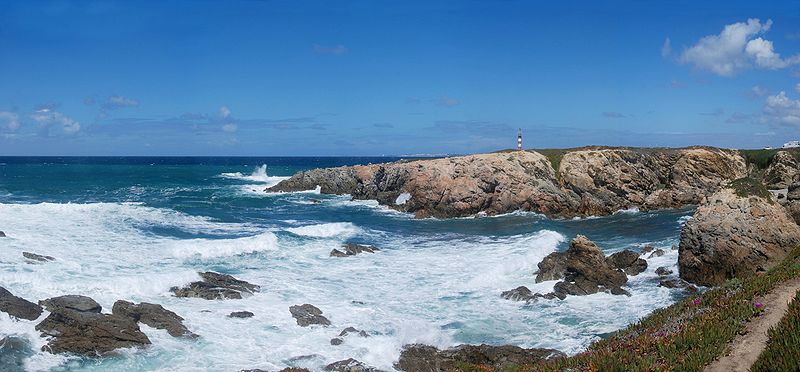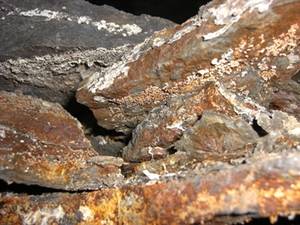Coastal Erosion at the microbial level
Interview with
Charles Cockell - Erosion is a big problem and a large percentage, well over 15% of the UK's coast is subject to coastal erosion. Now this is a natural problem of course and wave action and tidal action causes coastlines to erode but of course it's become more of a problem recently  given our concerns about rising sea levels, also human manipulation of coastal regions that can cause some areas of coast to erode much more quickly than others. Tidal breaks and these sorts of things can cause artificially fast rates of erosion.
given our concerns about rising sea levels, also human manipulation of coastal regions that can cause some areas of coast to erode much more quickly than others. Tidal breaks and these sorts of things can cause artificially fast rates of erosion.
Meera - But you've been particularly looking at an area of the coast along the North Yorkshire coastline.
Charles - That's right, this is an area where there are shales that are weathering quite quickly.
Meera - So what have been thought, up until now, are the causes of this erosion on that coastline?
Charles - So up until now, people have been focusing on the large scale, so they've mapped the faces of these cliffs and seen large scale rock falls, and really begun to understand the physics of how erosion occurs down to the cm scale. But it's still not really understood what's happening at the very small scale, literally the micron scale, the scale of micro-organisms. How do those chemical processes cause erosion and what sort of processes might be involved in causing our coastal erosion. And that's where we come in, because of course microbes are very, very small, a micron in size, and they might be relevant to erosion at these very small scales.
Meera - So the coastline you've been looking at is made up of shale as you've said - which microbes are thought to be having an effect here and what are they actually doing in this area?
Charles - Well we know that microbes can oxidise iron in shale, so they oxidise it and turn it into iron oxide, rust basically, and those new minerals  that are formed can form in the cracks of rocks and contribute to their degradation. But in our rocks we found that very few of the iron oxidises that we found, or if in fact very few of the microbes in that environment were related to things that had been studied before. So we think that there's a novel microbial community in there that is responsible for weathering the rocks. But what's basically happening is that the microbes are basically eating the various minerals in the rocks as a source of energy and in the process they are breaking down the rocks but they're also producing new minerals that are formed on the rock surfaces. And they form in tiny fractures inside the rock and they contribute to the weakening of the rock and eventually to its large scale deterioration and collapse. And that's how a little creature, a micron in size, can actually contribute to erosion on a kilometre scale.
that are formed can form in the cracks of rocks and contribute to their degradation. But in our rocks we found that very few of the iron oxidises that we found, or if in fact very few of the microbes in that environment were related to things that had been studied before. So we think that there's a novel microbial community in there that is responsible for weathering the rocks. But what's basically happening is that the microbes are basically eating the various minerals in the rocks as a source of energy and in the process they are breaking down the rocks but they're also producing new minerals that are formed on the rock surfaces. And they form in tiny fractures inside the rock and they contribute to the weakening of the rock and eventually to its large scale deterioration and collapse. And that's how a little creature, a micron in size, can actually contribute to erosion on a kilometre scale.
Meera - So what microbes are these and how much are they thought to be contributing to erosion on this particular coastline?
Charles - The varieties of microbes are very large. We've extracted the DNA, we've looked at the community and there are all sorts of microbes in there that we don't really understand and we don't know what they're doing. What their contribution is a big question. We know they're there, but we don't know which ones are active in breaking down the rocks and how much they contribute towards forming the minerals. Because what we do know is that weathering can also occur chemically without the microbes, so the next challenge is really to understand the contribution of the microbial community.
Meera - Let's go a bit into how you've been looking into the effects of these microbes, or perhaps how they're even working. This is where you've been using the Diamond synchrotron, but an interesting aspect is that you've been using quite a few different techniques at Diamond to look at very many aspects of the microbes.
Charles - That's right, we use a number of methods. We've been using biological methods where we extract the DNA and we try to understand what the microbial community is doing inside the fractures and how they are distributed and what types of microbes are there. Essentially what we're asking is the question 'Who's in there?'. But we are also interested in understanding the mineral that surround them. What are those minerals, what structure do they have, could they have been produced by microbes? And that's where Diamond comes in, because we can use Diamond to map the different types of iron minerals on the surface of the rock. Try and understand their relationship to the rock surface and what characteristics they have and so we've been using Diamond to map the surface of the weathered fractures in the coastally eroded cliffs. We will then go on to see whether microbes can produce these types of minerals.
Meera - How useful then would you say these techniques are?
Charles - They are extremely important because they allow us to really probe the structure of the minerals. It's one thing just to know what their composition is, but we wanted to know their structure. We also wanted to know how they are distributed on the surface of the rock; are they localised in one place, are they evenly distributed? That tells us a bit about the way in which the rocks are breaking down.
Meera - How would you summarise your findings so far and I guess at the end of it all, what's the aim? I guess we can't obviously prevent it, what could be done using this information?
Charles - Well in terms of stopping these things, it's interesting you say that, the assumption is that we can't do anything about it, the microbes just eat the rocks, but in fact there are fascinating questions about if you know what microbes are weathering these rocks, could you slow them down? Is it possible that as the sea level rises, salt water will actually kill off some of these weathering microbes and slow the process down? Or will new types of microbes take over?
Meera - Another important thing to consider is that the impact of these microbes isn't just limited to the erosion of the actual coast, there's greater effects spanning from this.
Charles - Yes, absolutely. I mean the work that we do gives us a much broader insight into the role of microbes breaking down rocks generally. What role do these microbes play in other shale environments? Shale has a very important role in engineering structures. Many Motorway bridges, for example, in the UK are built on shale, or near shale, and the microbes that break down shale might have serious implications for civil engineering and civil infrastructure as well. So these studies of how microbes break down rocks, has quality of life implications as well.










Comments
Add a comment